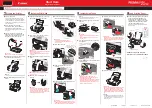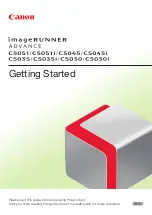
Output / finishing
Introduction
In JDF, the finishing operations like punch, fold and staple are applied on the trailing edge (left) of
the job, or the top left corner of the trailing edge (top left). To set the finishing operations on
other edges, a virtual transformation on he input of a finishing process must be defined.
Transformations are applied as follows:
1. Rotate the media sheet counter clockwise.
2. If Flip is specified, flip the media sheet upside down. After this rotation, the top edge is on the
bottom and the back side is on the front.
3. Apply finishing on the new left edge, or the new top left corner, after the transformation.
The media sheet is always considered as portrait-oriented, i.e the left edge is always the large
edge, regardless of the orientation of the content.
The meaning of the JDF @Orientation is given in the following table:
@Orientation values
Trailing edge
Corner
Rotate0 (default)
Left
LeftTop
Rotate90
Top
TopRight
Rotate180
Right
RightBottom
Rotate270
Bottom
BottomLeft
Flip0
Left
LeftBottom
Flip90
Top
TopLeft
Flip180
Right
RightTop
Flip270
Bottom
BottomRight
Orientation (for finishing process)
Syntax for input
XPath: /JDF/ResourceLinkPool/ComponentLink[@Usage=”Input” and @CombinedProcessIndex]]/
@Orientation
Syntax for output
XPath: /JDF/ResourceLinkPool/ComponentLink[@Usage=”Output” and
@CombinedProcessIndex]/@Orientation
Description
In case several successive finishing are specified, the ComponentLink[@Usage=”Output”] must
be specified.
@CombinedProcessIndex is an integer which refers to the Process index on which the
transformation must be applied. The Process index is the position of the Process in the JDF node
attribute @Types, starting with zero.
Example: Staple dual top
<JDF ID="jdf_1" Type="Combined" Category="DigitalPrinting" Types="LayoutPreparation
Imposition Interpreting Rendering DigitalPrinting Stitching">
<ResourcePool>
Output / finishing
Chapter 10 - JDF interface specification
257
imagePRESS C7010VPS series v2.2
Summary of Contents for imagePRESS C7010VPS series
Page 8: ...Contents 8 imagePRESS C7010VPS series v2 2...
Page 9: ...Chapter 1 Introduction...
Page 14: ...Supported media 14 Chapter 1 Introduction imagePRESS C7010VPS series v2 2...
Page 15: ...Chapter 2 PRISMAsync...
Page 29: ...Chapter 3 The LPD connection...
Page 45: ...Chapter 4 The socket connection...
Page 51: ...Chapter 5 Adobe PostScript 3...
Page 64: ...Bind 64 Chapter 5 Adobe PostScript 3 imagePRESS C7010VPS series v2 2...
Page 86: ...Staple 86 Chapter 5 Adobe PostScript 3 imagePRESS C7010VPS series v2 2...
Page 89: ...Trim Chapter 5 Adobe PostScript 3 89 imagePRESS C7010VPS series v2 2...
Page 99: ...Chapter 6 PDF...
Page 117: ...Chapter 7 Colour management...
Page 133: ...Chapter 8 Accounting...
Page 150: ...Implementation aspects 150 Chapter 8 Accounting imagePRESS C7010VPS series v2 2...
Page 151: ...Chapter 9 SNMP...
Page 159: ...Example in pseudo code Chapter 9 SNMP 159 imagePRESS C7010VPS series v2 2...
Page 222: ...ppmPortGroup 222 Chapter 9 SNMP imagePRESS C7010VPS series v2 2...
Page 223: ...Chapter 10 JDF interface specification...
Page 291: ...Basic JDF ticket Chapter 10 JDF interface specification 291 imagePRESS C7010VPS series v2 2...
Page 297: ...Chapter 11 SMB printing...
Page 303: ...Chapter 12 Hot folder printing...
Page 306: ...Hot folder 306 Chapter 12 Hot folder printing imagePRESS C7010VPS series v2 2...
Page 307: ...Chapter 13 Scan to file and scan to email...
Page 313: ...Chapter 14 SRA IPDS...
Page 361: ......
















































